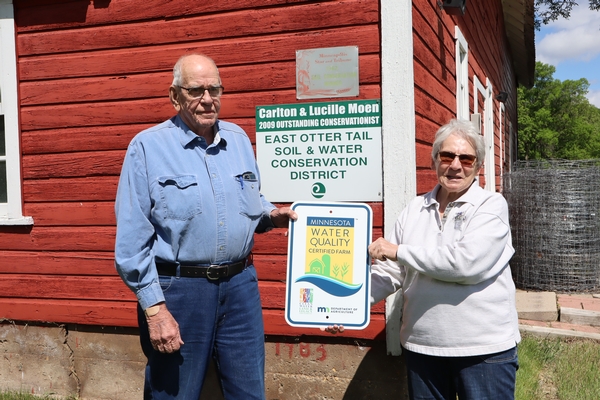July 18, 2024 by Alyson Levig
Nestled into the rolling hills of Deer Creek Township in East Otter Tail County lies the Moen homestead, the starting point of a farming operation established in 1951 by Carlton Moen’s father, Luther. Back then, Rock Creek Valley and the surrounding sandy-loam hills fed fifteen head of cattle and taught the Moen family lessons in erosion’s power. As the picturesque hilltops began washing out because of the previous owners’ conventional tillage, Moen’s father switched to contour farming (tilling along the lines of consistent elevation to conserve rainwater and reduce erosion) and was one of the first to do so in the area. The switch deemed the farming operation as the Minneapolis Star Tribune Soil Conservationist winner in 1962.
Carlton also made some big management adjustments once he took over the farming operation in 1978. This change dealt with the cattle herd and was based on a comment by a nephew attending the Moen family reunion.
“I remember my nephew saying, ‘Look, that cow is peeing in the water, and the others are drinking it!’ Once I heard that and thought about it, we fenced off all cattle access to the creek.” Carl explained.
Eventually, he also enrolled all his cropland in the Conservation Reserve Program (CRP) to be converted to warm-season grasses for wildlife habitat. These actions, as well as others, earned both Carlton and his wife, Lucille, the title of Outstanding Conservationist in 2009 by the East Otter Tail Soil and Water Conservation District (SWCD).
In 2023, Carlton was introduced to the Minnesota Agricultural Water Quality Certification Program (MAWQCP) after inquiring about grazing advice through the East Otter Tail Soil and Water Conservation District. The MAWQCP program, which originated in 2014, is a voluntary process that certifies farming operations utilizing conservation-minded practices to protect water quality throughout Minnesota for 10 years.
With guidance from both the SWCD and the MAWQCP, the Moens’ operation now rotationally graze their remaining acres of pasture from June through October, with cows being moved to a new paddock each week. This management practice encourages the recovery of previously grazed vegetation while preventing soil erosion and promoting water quality.
“Water is a very important resource,” Carlton said, “so if there are opportunities to help protect it—get involved!” And that’s what the Moens intend to do. Since becoming certified on August 25, 2023, Carlton and Lucille have also earned the wildlife endorsement through the MAWQCP. Overall, the Moens’ farming operation now accompanies over 1,500 producers throughout the state farming more than one million acres within the program.
Carlton credits the increase of ospreys in the area to his management practices and others. For example, about ten years ago, some ospreys nested on the powerline pole near Rock Creek which flows through the Moens’ farm.
“The company who owned the powerline removed the nest twice before I suggested they provide a replacement pole for the ospreys to build their nest. Ultimately, our electricity supplier provided the pole and suggested I provide the nesting base (an old steel wheel),” Carlton said. “For the last two years, a pair of ospreys have called the wheel home. Now, this year, there are four osprey nesting sites near the east end of East Leaf Lake. This indicates to me that the quality of water in the East Leaf Lake watershed has attracted the additional osprey pairs.”
But Moen also emphasized that, “improving and maintaining water quality is not an individual goal; it takes the cooperation of many people to achieve it. So, it wasn’t just my action of fencing the cattle out of Rock Creek that helped to improve the water quality, but also the implementation of riparian buffers to filter the water flowing into the creek. Also, the reduction of dairy operations along Rock Creek allowing cattle access to the creek played a part. Fifty years ago, there were 8-10 operations; mine was the last to stop that practice, so now there are none.”
Altogether, the Moens’ current management practices in their farming operation result in the conservation of natural resources within East Otter Tail County, where water quality is protected, and soil erosion is reduced.
Posted In: MAWQCP


